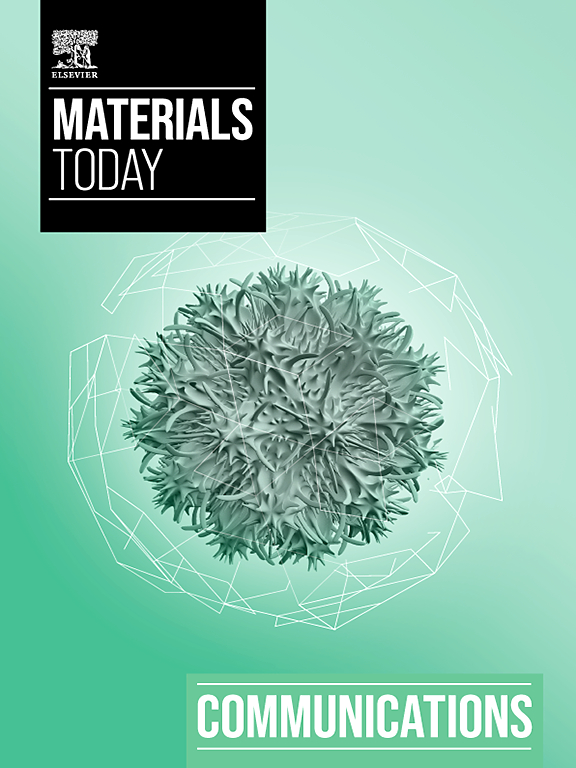Green synthesis of biomass-derived porous carbon with hierarchical pores and enhanced surface area for superior VOCs adsorption
IF 3.7
3区 材料科学
Q2 MATERIALS SCIENCE, MULTIDISCIPLINARY
引用次数: 0
Abstract
The release of volatile organic compounds (VOCs) during the production, storage, and transportation of petroleum and its derivatives can be hazardous to human health and lead to secondary pollution. Addressing this challenge, this study introduces a sustainable and low-energy approach for synthesizing high-efficiency porous carbon materials, leveraging the abundant and renewable watermelon rinds as a carbon source. The carbonization and activation processes were optimized to minimize energy consumption while maximizing adsorptive performance. In this research, watermelon rinds were used as a source of carbon production, and melamine phosphate (FR-MP) was employed as a modifying agent. The FR-MP modified porous biomass-derived activated carbon (PWAC) was created by subjecting it to physical milling, carbonization, and activation. This approach not only utilized a waste biomass effectively but also reduced the overall carbon footprint of the production process. An examination of the effects of FR-MP dosage on the pore structure, surface chemical properties, and VOCs adsorption abilities of PWAC revealed that a higher FR-MP dosage resulted in a wider range of pore sizes within PWAC. The incorporation of FR-MP intensified the development of internal porosity and pore expansion in PWAC. Specifically, the optimized PWAC-0.3 exhibited a significant increase in specific surface area (3149 m²/g) and pore volume (1.76 cm³/g), enhancing adsorption capacities for acetone and n-hexane up to 1046 mg/g and 760 mg/g, respectively. Furthermore, the PWAC demonstrated exceptional recyclability, maintaining 97% of its original adsorption capacity after five cycles, underscoring its sustainable and economic viability. The highly advanced hierarchical ultra-meso-macroporous structure of PWAC significantly reduced the diffusion resistance of VOCs, guaranteeing swift mass transfer and desorption of VOCs. Consequently, the developed PWAC represents a novel, cost-effective, and environmentally-friendly approach for VOCs adsorption, aligning with the principles of green chemistry and low-energy consumption. This research not only provides a promising solution for VOCs mitigation but also highlights the potential of waste biomass in producing high-performance carbon materials.

具有分层孔隙和增强表面积的生物质衍生多孔碳的绿色合成,可实现优异的挥发性有机化合物吸附性能
石油及其衍生物在生产、储存和运输过程中释放出的挥发性有机化合物(VOC)会危害人体健康,并导致二次污染。为了应对这一挑战,本研究利用丰富且可再生的西瓜皮作为碳源,引入了一种可持续且低能耗的方法来合成高效多孔碳材料。对碳化和活化过程进行了优化,以最大限度地降低能耗,同时最大限度地提高吸附性能。在这项研究中,西瓜皮被用作碳生产源,磷酸三聚氰胺(FR-MP)被用作改性剂。通过对其进行物理研磨、碳化和活化,制成了 FR-MP 改性多孔生物质活性炭(PWAC)。这种方法不仅有效利用了废弃生物质,还减少了生产过程中的总体碳足迹。通过研究 FR-MP 用量对 PWAC 的孔隙结构、表面化学特性和挥发性有机化合物吸附能力的影响,发现 FR-MP 用量越高,PWAC 的孔隙尺寸范围越大。FR-MP 的加入加强了 PWAC 内部孔隙率和孔隙扩张的发展。具体而言,优化后的 PWAC-0.3 比表面积(3149 m²/g)和孔体积(1.76 cm³/g)显著增加,对丙酮和正己烷的吸附能力分别提高到 1046 mg/g 和 760 mg/g。此外,PWAC 还表现出卓越的可回收性,在循环使用五次后仍能保持 97% 的原始吸附能力,突出表明了其可持续的经济可行性。PWAC 先进的分层超大介孔结构大大降低了 VOC 的扩散阻力,保证了 VOC 的快速传质和解吸。因此,所开发的 PWAC 是一种新型、经济、环保的 VOCs 吸附方法,符合绿色化学和低能耗的原则。这项研究不仅为缓解挥发性有机化合物提供了一种前景广阔的解决方案,还凸显了废弃生物质在生产高性能碳材料方面的潜力。
本文章由计算机程序翻译,如有差异,请以英文原文为准。
求助全文
约1分钟内获得全文
求助全文
来源期刊

Materials Today Communications
Materials Science-General Materials Science
CiteScore
5.20
自引率
5.30%
发文量
1783
审稿时长
51 days
期刊介绍:
Materials Today Communications is a primary research journal covering all areas of materials science. The journal offers the materials community an innovative, efficient and flexible route for the publication of original research which has not found the right home on first submission.
 求助内容:
求助内容: 应助结果提醒方式:
应助结果提醒方式:


